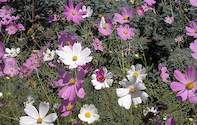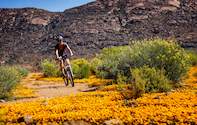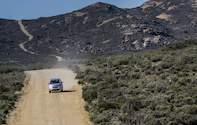
North of Cape Town, hot, volcanic plains stride down to a cold Atlantic ocean. Namaqualand is the outback, a wilderness strewn with mines and mission stations, diamonds and dust. However, for a few frivolous weeks in spring, the granite hills and lava lowlands erupt with flowers.
About 4 000 species of plant lie dormant amongst the sand and stone, their germination dependent upon weather conditions. Each year's floral display is therefore unique, enticing itinerant flower-gazers along the far-flung length of the N7 to Namibia.
In this semi-desert, it is the uncertain winter rainfall that determines the flowers. Spring starts somewhere between August and September and timing is everything. The season begins in the Sandveld strip on the west coast and the area around Springbok and Steinkopf, further north.
As the weather becomes warmer the flowers flow eastward toward the mountains and on brightly-lit days between 11am and 4pm, with the sun at your back, the resulting full-frontal spectacle is positively psychedelic.
550 kilometres north of Cape Town and over a hundred kilometres from the west coast, the most popular flower routes cluster around Springbok, the only town worthy of the designation on the long march north to Namibia. 15 kilometres outside of Springbok is the 15 000 hectare Goegap Nature Reserve which encompasses the Hester Malan Wildflower Reserve.
Named after the wife of one of the apartheid era bureaucrats of the Cape, the reserve was extended in 1990 and also got a new name. Goegap is Nama for waterhole, an evocative title when summer temperatures can climb as high as 48° degrees C.
Driving, Cycling and Hiking Trails

Driving, cycling and hiking trails promise close encounters with the 600 indigenous flower species, springbok, gemsbok and mountain zebra which call the Goegap home. The reserve's 17 kilometre circular driving route is on good roads with ample picnic sites and limited overnight facilities, including a self-catering group chalet and a smaller cottage.
Somewhat closer to Cape Town than the rest of the region's flower routes, the so-called Garden Route of Namaqualand is cooler than the hinterland and you're more likely to find flowers here late in the season. A dirt-road ramble through Kamieskroon, Leliefontein, and Garies via the Kamiesberg Pass offers history and scenery in equal measure.
The Leliefontein mission station has one of the oldest churches in Namaqualand while 10 kilometres down the Gamoep road there is a turn-off for Nourivier where traditional Nama reed huts may still be seen.
Pick up the N7 once more at Garies via the off-the-map pinprick of Karas which is famous for its yellow catstails (Bulbinella Latifolia.) For the more adventurous, 4x4 routes wend their way through this succulent-studded African Arizona. 67 kilometres south of Springbok, scenic Kamieskroon is the town that couldn't settle down.
When the early settlement outgrew the narrow ravine in which it had first made its home, the village moved, lock and livestock, to a more expansive site. Front-runner for the title of 'Most Attractive Town in Namaqualand,' Kamieskroon is surrounded by craggy peaks unlike the flat monotony of much of the landscape bordering the N7.
Accordingly, photographic workshops are one of the attractions during the flower season as is the Kamieskroon hiking trail among the rock formations and wildflowers of the Kamiesberg range.
The nearby 1000 hectare Skilpad Wild Flower Reserve, now part of a newly designated National Park west of Kamiekroon, is another draw-card. If all else fails, Skilpad will be sure to delight as the ground soaks up what little moisture comes in off the sea and in turn exudes dazzling blooms.
The Back Roads

Should you find yourself tickled by that back-roads itch, travelling south from Springbok to Kamieskroon, take the Hondeklipbaai turn-off for a 104 kilometre gravel-road detour to the coast.
Drive via the Messelpad Pass and Wildeperdehoek Pass to Soebatsfontein, a small village at the bottom of the escarpment that owes its existence in these parched climes to the local spring. And thence to the popular holiday spot of Hondeklip Bay which entertains fishing and diamond mining boats as well as local fishing fans.
Head inland once more, either south to Garies or circuitously to Kamieskroon to rejoin the N7. Alternatively, extend the off-road diversion south to the beaches of Groenriviermond where big red elandsvygies grow almost into the sea.
For those who are more back-road buffs than back-seat botanists, the 642 kilometre Namakwa 4x4 route which tracks the Orange River down to the sea, is the last word in Camel Man adventure. An equally audacious expedition is the Richtersveld National Park in the north-west corner of Namaqualand where the country's biggest mountain desert reserve juts into Namibia.
The Richtersveld is the driest region of Namaqualand with less than 50 mm of rain a year. Its attraction lies in its wild and arid loneliness, its briefly blooming spring flowers and its mighty river, the Orange which entices adventurers of the water-sport variety.
Flower season fluctuates between June and October depending on the rains but whatever the weather, you'll find 30% of South Africa's succulents here. The eerily contorted, silhouetted skeletons of the halfmens tree is emblematic of the region.
A well-stocked 4x4 is recommended for excursions into this timeless wilderness and pack a tent as caravans won't cut it. The camping sites within the park have no facilities other than braai areas and fresh water is only available at the park headquarters at Sendelingsdrift.
Belying the impression of the uninitiated that the land of the Nama is dry and lifeless, Namaqualand's many moods and faces hold a perennial fascination for the intrepid wayfarer and her annual reminder to stop and smell the daisies is counsel well advised.
By Laurianne Classe

 Each year the wild flowers appear from late March to October, and peak in August and September. In the centre of this floral phenomenon lies...
Each year the wild flowers appear from late March to October, and peak in August and September. In the centre of this floral phenomenon lies...